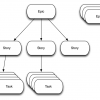 |
Product Owner, Product Manager, or Project Owner? If you really want to get the benefit of Scrum, you have to make the mind shift to product ownership, not project management or project ownership. The product owner role is often thought of as being a requirements specifier, when in fact a good product owner is a value maximizer, and a great product owner is a product maximizer.
|
|
 |
The Scrum Daily Standup Meeting: Your Questions Answered The daily standup, or daily scrum, is a short meeting the team uses to briefly communicate work commitments with each other. Dick Carlson answers some questions that agile teams, management, stakeholders, and those who are thinking about transitioning to agile commonly have about these daily standup meetings.
|
|
 |
Stories, Epics, and Tasks: Organizing Agile Requirements Some teams only work with stories, but it can be difficult for a team new to agile to write stories that are easy to understand and provide value every time. An alternative is to add epics and tasks. Understanding the differences between each level and knowing what size story to use for each situation will improve the accuracy of your sprint planning.
|
|
 |
How Business Teams Can Embrace Agile Techniques As agile principles and practices receive greater organizational exposure, business teams are embracing certain aspects of agility that were traditionally reserved for technology teams. This article details the experiences of a group of people with business roles who have adopted some agile methods and how their teams have benefitted.
|
|
 |
The Art of Maximizing Work Not Done One of the twelve principles behind the Agile Manifesto is “Simplicity—the art of maximizing the amount of work not done—is essential.” Why is this principle called an art, while the others aren’t? And why should we maximize the amount of work "not" done? This article analyzes the importance of simplicity in agile projects.
|
|
 |
Help Your Team Understand Its Iteration Burndown A good key indicator for measuring how well your agile team is performing is the burndown chart. It’s a simple concept—as time passes, the amount of work to do decreases. Of course, there will be days when progress is not as expected or tasks end up larger than originally estimated. A burndown can help your team reset and keep stakeholders in the loop.
|
|
 |
Are You Ready for Go-Live? 8 Essential Questions As real and daunting as scheduling pressures can be, they have to be balanced with the consequences of a potentially disastrous premature go-live. Don’t let all the reasons a system simply "must" be implemented by a target date overwhelm compelling evidence that it is not ready. Consider these eight questions honestly first.
|
|
 |
Inside the Mind of the 21st Century Customer
Slideshow
Testers frequently say that they are the voice of the customer or the customer advocate for their organization’s products. In some situations this can be a helpful mindset, but no matter how hard he tries, a software tester is not the customer. In fact, there is no one better suited to...
|
Alan Page, Microsoft
|
 |
Better Software Conference West 2015: Making Numbers Count: Metrics That Matter As testers and test managers, we are frequently asked to report to stakeholders on the progress and results of our testing. Questions like How is testing going? may seem simple enough, but the answer is ultimately based on our ability to extract useful metrics from our work and present...
|
Mike Trites, PQA Testing
|
 |
User Story Points versus Man-Hours: Estimating Effort Better Effort estimation is a major challenge for all the stakeholders of a project. Most people generally underestimate situations that may block progress and consider only the best-case scenario for a project. Your choice of estimation method may not be helping, though. Which would be better for your team: estimating by man-hours or by user story points?
|
|
